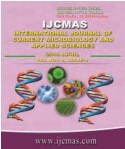


 National Academy of Agricultural Sciences (NAAS)
National Academy of Agricultural Sciences (NAAS)

|
PRINT ISSN : 2319-7692
Online ISSN : 2319-7706 Issues : 12 per year Publisher : Excellent Publishers Email : editorijcmas@gmail.com / submit@ijcmas.com Editor-in-chief: Dr.M.Prakash Index Copernicus ICV 2018: 95.39 NAAS RATING 2020: 5.38 |
Morphometric analysis, which refers to the science of quantitative analysis of land surface, has been carried on Kamleshwar watershed of Hiran River in Gujarat using remote sensing and GIS techniques. Digital Elevation Model of 30 m × 30 m resolution was used to prepare the detailed drainage map in ArcGIS software and stream ordering was in which study area has trunk order of 5. Total seventeen morphometric parameters including linear, areal and relief aspects have been estimated. Mean bifurcation ratio of the watershed has been calculated to be 3.84 which indicates slightly dissected drainage basin. Low drainage density of 2.18 km/km2 very well explains high infiltration in soil and less runoff due to dense forest cover. Drainage texture of 4.08 km-1 is coarse to moderate leading to reduce soil erosion. Form factor ratio and elongation ratio are 0.35 and 0.67 respectively which favours in lower peaks of longer duration with elongated watershed, which is good for avoiding the floods in downstream. Relatively low relief ratio of 0.016 translates low intensity of erosion processes. Low drainage density and relief results in moderately low ruggedness number of 0.52. The study shows potential usefulness of GIS techniques in determining geomorphological landforms of forest watersheds which can be useful in various hydrologic modelling studies.
 |
 |
 |
 |
 |